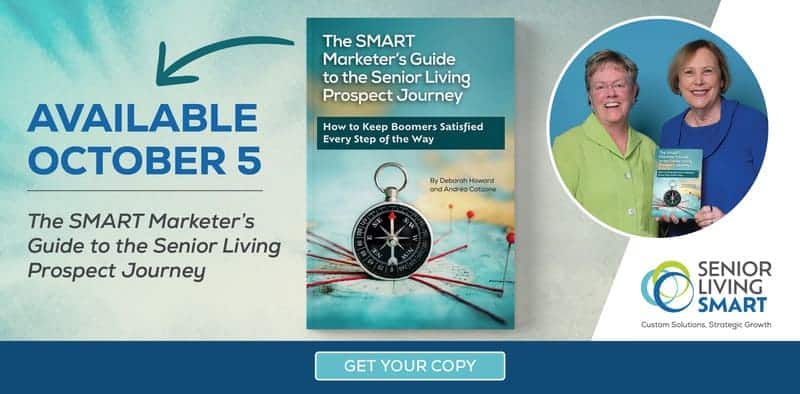3 Senior Living Marketing Analytics Every COO Should Know
As a senior living COO, you’ve been tasked with overseeing the daily operations of your communities. You work closely with leadership at all levels, capital partners, vendors and suppliers. You are responsible for developing and executing a clear operational plan that often includes a multi-year vision for your organization.
You likely have a keen financial intellect and a strong understanding of analytics in general. But you’re also acutely aware that you can’t always know what you don’t know, especially when it comes to digital marketing analytics.
Don’t worry—we got you!
3 senior living marketing analytics every COO should know
1. Google Analytics: Traffic and Traffic Sources
You don’t need to get into the weeds since you’re paying your marketing team to manage your Google Analytics account, but smart senior living COOs should still have a working knowledge of website traffic and traffic sources (and how not to get fooled by the “more is always better” trap).
Website traffic: focus on quality over quantity
It’s certainly good news to see website traffic increasing, provided the lead quality and conversions correspond accordingly.
Remember, the ultimate measure of quality website traffic is conversions, so if your site is bringing in a lot of traffic but it isn’t converting, this indicates a disconnect. Maybe the site isn’t optimized for the right search terms and is bringing in visitors who are not looking for senior living at all. Maybe the site doesn’t have compelling content that entices people to act. Or maybe the site performs so poorly technically that visitors leave before engaging in any way.
When we optimize our clients’ sites for the first time, we explain that it’s OK if overall traffic goes down as long as quality lead conversions increase. (Then, from there, we focus on attracting more of the right traffic. Which means traffic should trend up from that point.)
Traffic sources: which ones convert best?
As for traffic sources, you’ll want to know which sources—organic, paid, social, direct—yield the best leads since this will guide your budget. For example, why spend valuable dollars on a social media platform like TikTok if it doesn’t move the needle?
- KEY TAKEAWAY: Asking your team to provide regular updates about website traffic, sources, and lead conversions will give you a solid snapshot of the site’s overall health and ability to generate quality leads.
2. Paid Advertising: Conversion Rate and Cost Per Lead
Paid advertising, especially Google Ads, can be an excellent way for senior living communities to compete—provided the ad strategy is sound.
We’ve written an article that takes a deep dive into Google Ads, but here are the highlights you need to know:
What’s a good conversion rate for senior living PPC ads?
A conversion rate for pay-per-click (PPC) ads is the percentage of people who convert after clicking your ad.
The definition of “convert” will vary depending on the advertiser. An e-commerce store running ads for sneakers will consider a sale to be a conversion. In senior living though, there’s a much longer sales cycle. We don’t expect someone to click on an ad and convert into a resident. Instead, our goal is to convert the person into a lead.
For example, if someone clicks on a senior living PPC ad, they might go to a landing page to download an educational guide in exchange for their name and email address. That’s the conversion point.
Senior living PPC conversion rates can vary depending on geographies and a community’s budget. Generally, we like to see conversion rates between 8 to 15%.
What are some benchmarks for costs per lead?
Reminder, we’re publishing this post in July 2023. Numbers will fluctuate.
Independent living
- Low end: $18
- Upper end: $45 to $50
Assisted living
- Low end: $38 to $40.
- High end: $80 to $100
Memory care
- Low end: $100 to $120
- High end: $400+
Memory care is the most expensive because it’s the most competitive. People searching for memory care are often ready to convert due to an urgent need.
- KEY TAKEAWAY: When it comes to paid advertising, ask your paid ads team about conversion rates and lead costs to ensure they align with current benchmarks in senior living.
3. Customer Lifetime Value (aka Resident Lifetime Value)
The resident lifetime value is the revenue you can expect the average resident to generate throughout their stay.
You will have different resident lifetime values for different levels of care. For example, maybe your memory care resident stays 14 months on average, while the average resident in your CCRC community stays eight years (96 months).
The way you calculate the average resident lifetime value is straightforward: Length of stay (in months) multiplied by the monthly rent (plus the entrance fee, if applicable).
- EXAMPLE: Going back to our memory care example above. Let’s say the monthly rent is $6,000. The resident lifetime value for MC, in this case, would be $84,000 (14 months x $6000/month).
Knowing the average length of stay is incredibly helpful for forecasting occupancy. And knowing the resident lifetime value can help predict your return on investment (ROI), potential lost revenue, and return on marketing investment (ROMI).
For example, let’s say the average length of stay for assisted living in one of your communities is 24 months. Now, let’s pretend you have six AL residents who move in the same month. In 24 months, you could face six vacancies on top of your “normal” vacancies.
Knowing this, you can reverse-engineer your marketing budget and marketing tactics in anticipation. For example, let’s say you know that you successfully convert AL leads from Google Ads. You could budget for an increase in paid advertising in the month or two before the six apartments are due to open up. And you can justify why when reporting to leadership/capital partners.
- KEY TAKEAWAY: You can’t create accurate marketing budgets if you don’t have a handle on the lifetime value of a resident or the average length of stay. Remember, you must calculate these numbers for every level of care across every community in your portfolio.
Ready to look like a marketing rock star in front of the leadership team?
We love working with senior living COOs and making them look smart in front of leadership and capital partners. Let’s explore how we might work together.





